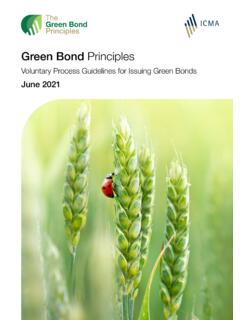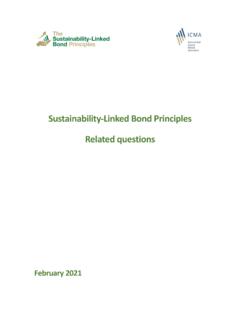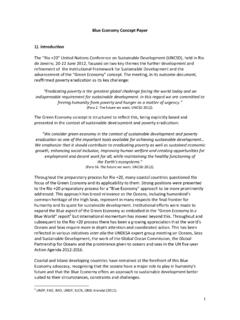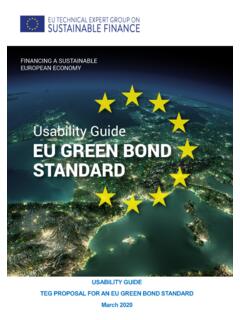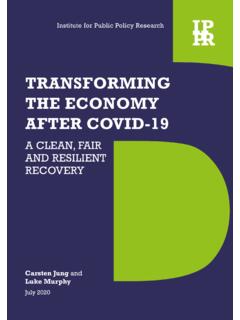Transcription of Green Bond Principles - International Capital Market ...
1 Green Bond PrinciplesVoluntary Process Guidelines for Issuing Green BondsJune 2021 IntroductionThe Green Bond Principles (GBP), together with the Social Bond Principles (SBP), the Sustainability Bond Guidelines (SBG) and the Sustainability-Linked Bond Principles (SLBP) are published under the governance of the Principles . The Principles are a collection of voluntary frameworks with the stated mission and vision of promoting the role that global debt Capital markets can play in financing progress towards environmental and social sustainability. The Principles outline best practices when issuing bonds serving social and/or environmental purposes through global guidelines and recommendations that promote transparency and disclosure, thereby underpinning the integrity of the Market .
2 The Principles also raise awareness of the importance of environmental and social impact among financial Market participants, which ultimately aims to attract more Capital to support sustainable GBP seek to support issuers in financing environmentally sound and sustainable projects that foster a net-zero emissions economy and protect the environment. GBP-aligned issuance should provide transparent Green credentials alongside an investment opportunity. By recommending that issuers report on the use of Green Bond proceeds, the GBP promote a step change in transparency that facilitates the tracking of funds to environmental projects, while simultaneously aiming to improve insight into their estimated GBP provide high level categories for eligible Green Projects in recognition of the diversity of current views and of the ongoing development in the understanding of environmental issues and consequences, while referring when needed to other parties that provide complementary definitions, standards and taxonomies for determining the environmental sustainability of projects.
3 The GBP encourage all participants in the Market to use this foundation to develop their own robust practices, referencing a broad set of complementary criteria as GBP are collaborative and consultative in nature based on the contributions of Members and Observers of the Principles , and of the wider community of stakeholders. They are updated as required in order to reflect the development and growth of the global Green Bond Market . The GBP, and the Principles generally, are coordinated by the Executive Committee with the support of the addition to the GBP, the Principles offer approaches that reflect issuer level sustainability commitments, which can supplement or provide an alternative to a focus on use of proceeds. Such commitments can be expressed through Sustainability-Linked Bonds, as well as through dedicated issuer strategies and disclosures as recommended by the Climate Transition Finance Handbook when communicating Paris-aligned transition plans.
4 An illustration of the products and related guidance covered by the Principles is depicted in Appendix 2021 Green Bond PrinciplesVoluntary Process Guidelines for Issuing Green Bonds2 The 2021 Edition of the GBPThis edition of the GBP benefits from the feedback of the 2020 consultation of the Members and Observers of the Principles , the Advisory Council, as well as from the input of the working groups coordinated by the Executive Committee with the support of the Secretariat. Notably, the 2021 edition of the GBP identifies key recommendations regarding Green Bond Frameworks and External Reviews alongside the four core components of the GBP. It recommends heightened transparency for issuer-level sustainability strategies and commitments, and encourages information, if relevant, on the degree of alignment of projects with official or Market -based taxonomies.
5 Further, it provides guidance on issuer processes to identify mitigants to known material risks of negative social and/or environmental impacts. It also contains additional clarifications and updates relating to recommended Market practice. This edition otherwise includes important references to complementary guidance from the Principles included in the Climate Transition Finance Handbook, the Harmonised Framework for Impact Reporting and the Guidelines for External Reviews, which are supplemented by the Guidance Bond DefinitionGreen Bonds are any type of bond instrument where the proceeds or an equivalent amount will be exclusively applied to finance or re-finance, in part or in full, new and/or existing eligible Green Projects (see Use of Proceeds section below) and which are aligned with the four core components of the GBP.
6 Different types of Green Bonds exist in the Market . These are described in Appendix I. It is understood that certain eligible Green Projects may have social co-benefits, and that the classification of a use of proceeds bond as a Green Bond should be determined by the issuer based on its primary objectives for the underlying projects. (bonds that intentionally mix eligible Green and Social Projects are referred to as Sustainability Bonds, and specific guidance for these is provided separately in the Sustainability Bond Guidelines).It is important to note that Green Bonds should not be considered fungible with bonds that are not aligned with the four core components of the GBP. Bonds issued under earlier Green Bond Guidance released prior to this version are deemed consistent with the Process Guidelines for Issuing Green Bonds3 Green Bond PrinciplesThe Green Bond Principles (GBP) are voluntary process guidelines that recommend transparency and disclosure and promote integrity in the development of the Green Bond Market by clarifying the approach for issuance of a Green Bond.
7 The GBP are intended for broad use by the Market : they provide issuers with guidance on the key components involved in launching a credible Green Bond; they aid investors by promoting availability of information necessary to evaluate the environmental impact of their Green Bond investments; and they assist underwriters by offering vital steps that will facilitate transactions that preserve the integrity of the Market . The GBP recommend a clear process and disclosure for issuers, which investors, banks, underwriters, arrangers, placement agents and others may use to understand the characteristics of any given Green Bond. The GBP emphasise the required transparency, accuracy and integrity of the information that will be disclosed and reported by issuers to stakeholders through core components and key four core components for alignment with the GBP are:1.
8 Use of Proceeds 2. Process for Project Evaluation and Selection 3. Management of Proceeds 4. Reporting The key recommendations for heightened transparency are:(i) Green Bond Frameworks (ii) External Reviews1. Use of ProceedsThe cornerstone of a Green Bond is the utilisation of the proceeds of the bond for eligible Green Projects, which should be appropriately described in the legal documentation of the security. All designated eligible Green Projects should provide clear environmental benefits, which will be assessed and, where feasible, quantified by the issuer. In the event that all or a proportion of the proceeds are or may be used for refinancing, it is recommended that issuers provide an estimate of the share of financing vs. re-financing, and where appropriate, also clarify which investments or project portfolios may be refinanced, and, to the extent relevant, the expected look-back period for refinanced eligible Green Projects.
9 The GBP explicitly recognise several broad categories of eligibility for Green Projects, which contribute to environmental objectives such as: climate change mitigation, climate change adaptation, natural resource conservation, biodiversity conservation, and pollution prevention and control. The following list of project categories, while indicative, captures the most commonly used types of projects supported, or expected to be supported the Green Bond Market . Green Projects include assets, investments and other related and supporting expenditures such as R&D that may relate to more than one category and/or environmental objective. Three environmental objectives identified above (pollution prevention and control, biodiversity conservation and climate change adaptation) also serve as project categories in the list.
10 As such, they refer to the projects that are more specifically designed to meet these environmental eligible Green Projects categories, listed in no specific order, include, but are not limited to: Renewable energy (including production, transmission, appliances and products); Energy efficiency (such as in new and refurbished buildings, energy storage, district heating, smart grids, appliances and products); Pollution prevention and control (including reduction of air emissions, greenhouse gas control, soil remediation, waste prevention, waste reduction, waste recycling and energy/emission-efficient waste to energy); Environmentally sustainable management of living natural resources and land use (including environmentally sustainable agriculture; environmentally sustainable animal husbandry; climate smart farm inputs such as biological crop protection or drip-irrigation; environmentally sustainable Voluntary Process Guidelines for Issuing Green Bonds4fishery and aquaculture; environmentally sustainable forestry, including afforestation or reforestation, and preservation or restoration of natural landscapes); Terrestrial and aquatic biodiversity conservation (including the protection of coastal, marine and watershed environments).



